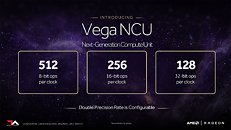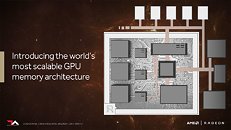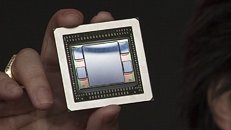Thursday, January 12th 2017

AMD's Vega-based Cards to Reportedly Launch in May 2017 - Leak
According to WCCFTech, AMD's next-generation Vega architecture of graphics cards will see its launch on consumer graphics solutions by May 2017. The website claims AMD will have Vega GPUs available in several SKUs, based on at least two different chips: Vega 10, the high-end part with apparently stupendous performance, and a lower-performance part, Vega 11, which is expected to succeed Polaris 10 in AMD's product-stack, offering slightly higher performance at vastly better performance/Watt. WCCFTech also point out that AMD may also show a dual-chip Vega 10×2 based card at the event, though they say it may only be available at a later date.AMD is expected to begin the "Vega" architecture lineup with the Vega 10, an upper-performance segment part designed to disrupt NVIDIA's high-end lineup, with a performance positioning somewhere between the GP104 and GP102. This chip should carry 4,096 stream processors, with up to 24 TFLOP/s 16-bit (half-precision) floating point performance. It will feature 8-16 GB of HBM2 memory with up to 512 GB/s memory bandwidth. AMD is looking at typical board power (TBP) ratings around 225W.
Next up, is "Vega 20", which is expected to be a die-shrink of Vega 10 to the 7 nm GF9 process being developed by GlobalFoundries. It will supposedly feature the same 4,096 stream processors, but likely at higher clocks, up to 32 GB of HBM2 memory at 1 TB/s, PCI-Express gen 4.0 bus support, and a typical board power of 150W.
AMD plans to roll out the "Navi" architecture some time in 2019, which means the company will use Vega as their graphics architecture for two years. There's even talk of a dual-GPU "Vega" product featuring a pair of Vega 10 ASICs.
Source:
WCCFTech
Next up, is "Vega 20", which is expected to be a die-shrink of Vega 10 to the 7 nm GF9 process being developed by GlobalFoundries. It will supposedly feature the same 4,096 stream processors, but likely at higher clocks, up to 32 GB of HBM2 memory at 1 TB/s, PCI-Express gen 4.0 bus support, and a typical board power of 150W.
AMD plans to roll out the "Navi" architecture some time in 2019, which means the company will use Vega as their graphics architecture for two years. There's even talk of a dual-GPU "Vega" product featuring a pair of Vega 10 ASICs.




187 Comments on AMD's Vega-based Cards to Reportedly Launch in May 2017 - Leak
And if Vega were more efficient, it would scale past Pascal.
And 80%? Wut?
All you need to do is remember back to the HD 4870 that cost HALF as much as the 280. It had that "Expensive and new" GDDR5.
Now I don't have a crystal ball, but that's how strong the Vega 10 card SHOULD be. If it isn't, it will be a complete failure unless it uses like 100w.
The 1080 for reference is only 15% stronger than the Fury X. So you think AMD will have trouble making a card more than 15% stronger than their 1.5 year old flagship?
Dude stop drinking Nvidia's marketing koolaid...
As for why people are so skeptical? I really am not sure, but my guess is Nvidia fanboys have just completely bought into Nvidia's marketing.
I mean at best Nvidia has a 33% efficiency advantage over AMD (Titan X vs 480). Just switching to HBM alone would make them equally efficient, and we already know that 14nm has become incredibly more efficient with recent maturity.
To compete with the Titan X AMD would have just had to scale up the 480 to a twice as big die. However they have done that, and then they overhauled the entire architecture. The RX Fury (Or 590?) should be a monster.
We all know the supply of HBM2 is low.There are mythical reports of super binnings of Polaris, but that's not a fair comparison.
This is a real world comparison:
(Note: Picture is cut)
Also that last slide showing efficiency or lack thereof is well known about the rx480 I admit it's a disappointment but this is NOT rx480 no? If it were, we wouldn't even have this discussion of even the hint of potential AMD could compete, no one would argue for it and no one would bother arguing against it for it would be obvious to all it was like an AMD CPU nowadays and just ok for price point only not performance.
I've checked >60 RX 480 reviews, both the initial and the more recent ones, and they all show power usage of ~150W +/-10%, in fact Techpowerup's measurements is slightly below average. There are no significant difference between the first batches and the more recent ones, and there are no significant difference between reference and non-reference boards, just the usual variance you'll get with every card. What matters is what you'll get when you buy a card, not what one out of every thousand cards claims to perform. It's disingenuous to claim that buyers will get a "95W" card, when we all know they'll get a ~150W card.
www.techpowerup.com/reviews/Zotac/GeForce_GTX_1080_Amp_Extreme/30.html
Compare RX 470 with 1060 3GB and RX 480 with 1060 6 GB at 1080p.
Furthermore let's see if AMD's new memory tech indeed cuts usage in half. If 8GB's of AMD acts as good as 16GB of Nvidia, Nvidia is the one who will need to step their game up.
The 1050 Ti is 62% better than the 470, though. www.techpowerup.com/reviews/Zotac/GeForce_GTX_1060_Mini_3_GB/30.html
It's also hilarious considering how GF's 14nm was clearly being rushed into usage before it was ready. Just look at how the "Power Hungry" Fury is only 15% behind the 1060. Pathetic Nvidia can barely stay ahead of AMD's 28nm :p
Still waiting for the 80% difference ...
And I'd love to see some verified testing of new Polaris cards that shows they really have 50% greater efficiency than when first introduced. The only thing I can find are rumors from 3 months ago.
These charts are not that hard to read!